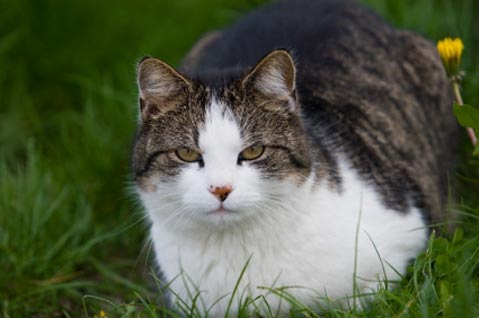Pet Obesity
How to Keep Your Pets Lean and Healthy

We all want to be kind to our pets and show affection in return for their unconditional love. In some cases, this translates into giving multiple treats or table scraps. In these instances, the amount of food we give our pets is simply too large, and this can be detrimental as it can lead to pet obesity.
The American Veterinary Medical Association estimates that of 54 million dogs and cats in the United States, more than one out of three are overweight. Compare that with the early 1970s, when less than one out of eight had a weight problem. Obesity can lead to such diseases as: osteoarthritis, type 2 diabetes, heart disease, hypertension, and many forms of cancer. Fat in the abdomen can cause labored breathing that leads pets to have increased anesthetic complications. Activity can be difficult for very overweight pets and you will very often see a decrease in heat tolerance and stamina. In addition, studies show that lean pets have an increased life span of up to two years, so get your pet’s weight under control.
The first step in controlling pet obesity is identifying that it exists in your pet. It is better to look at the appearance of each animal rather than at the weight of the animal. Dogs tend to carry their fat behind their front legs, along their back and at the base of their tail. Cats carry their fat along their lower abdomen. A body condition score is used as a classification. The scale ranges from 1 to 5. The pet is scored by looking at its build, the amount of fat overlying its ribs and its “waist.” A score of 1 would be a very thin animal with prominent ribs and spine. A score of 2 is an underweight animal with minimal fat cover. A score of 3 is ideal. The ribs can be felt but not seen and there is a slight waist. Scores 4 and 5 signify overweight and obese, respectively. In these conditions the ribs are difficult to feel and no waist can be seen.
Why are pets overweight? The answer is the same for pets as well as for people: too many calories and not enough exercise. If you determine that your pet is overweight, your veterinarian can work with you to develop a weight loss plan for your pet. The first step is to eliminate table scraps and reduce treats. Low-calorie treats are also available. Small amounts of boiled chicken can be given occasionally if someone in the house insists on giving your pet people food. A high-quality pet food is essential-be sure to read the ingredients. “By-products” are not as good as the real thing. Some experts believe a wet food only diet is the way to go as dry food has a higher fat and calorie content. As always, talk to your veterinarian before switching your pet’s food. Don’t forget about exercise! Exercise your pet 45 minutes daily for a dog or 20 minutes a day for a cat.
Tips for Exercising Your Cat
• Move the food bowl so it’s farther away from your cat’s normal hang out spots.
• Get your cat to chase feather toys, ping-pong balls, or a balled up piece of wax paper.
• Buy a remote controlled toy mouse and get your cat to chase it around the house.
• If your cat is an only cat, consider adopting another kitty for companionship as well as to keep your cat moving.
Tips for Exercising Your Dog
• Run or rollerblade with your dog.
• Play fetch or Frisbee in the park.
• Take your dog to the beach and let him swim.
• Buy a Buster Cube to feed your dog. You place your dog’s kibble inside the cube and your dog must roll the cube to get his food out. For more information, visit www.dogtoys.com/bustercube.html.
When dealing with pet obesity, prevention is key. It can be hard to get pets to lose weight, especially if it is an arthritic pet that cannot exercise. Keeping animals at a steady weight is a much easier task. As an old adage says: “An ounce of prevention is worth a pound of cure.”
Lisa Acho Remorenko is executive director of Animal Adoption Solutions.



